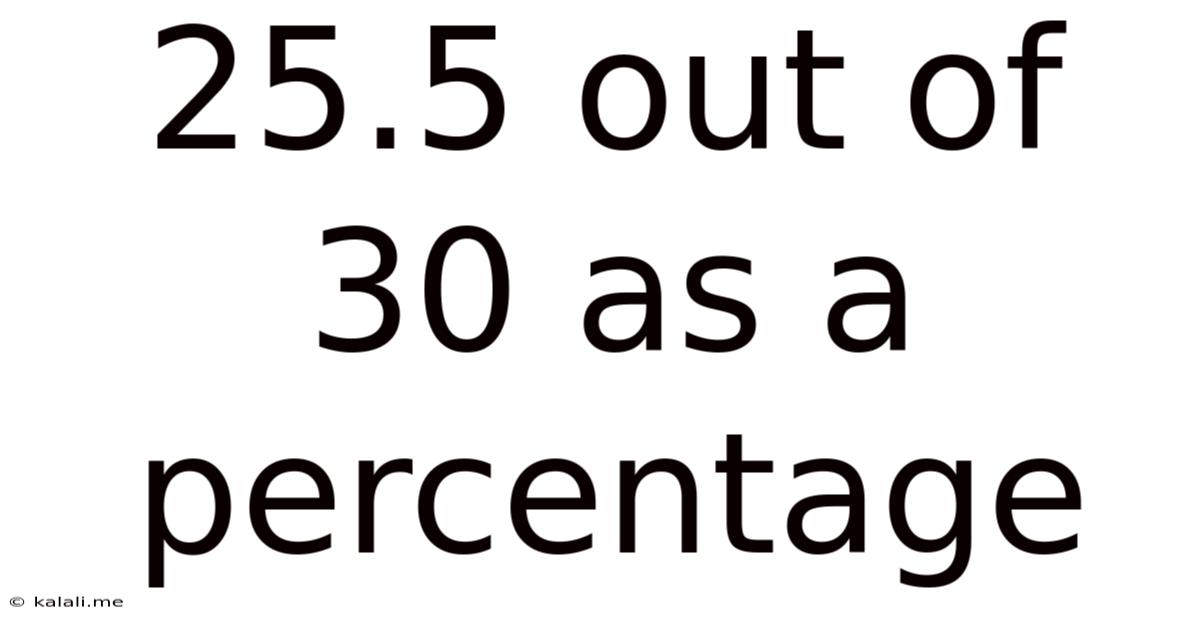25.5 Out Of 30 As A Percentage
Kalali
Jul 03, 2025 · 4 min read

Table of Contents
25.5 out of 30 as a Percentage: A Comprehensive Guide to Percentage Calculations
Calculating percentages is a fundamental skill applicable across various fields, from academic assessments to financial analysis. This article delves into the specifics of converting 25.5 out of 30 into a percentage, offering a detailed explanation of the process, practical applications, and related percentage calculations. Understanding this seemingly simple calculation provides a solid foundation for more complex percentage-based problems.
Understanding Percentages: The Basics
A percentage represents a fraction of 100. It expresses a proportion relative to a whole. The symbol "%" signifies "per hundred." Therefore, 50% means 50 out of 100, or 50/100, which simplifies to 1/2. Percentages are versatile and frequently used to represent various data, from test scores and discounts to interest rates and growth rates.
Calculating 25.5 out of 30 as a Percentage: The Step-by-Step Method
To determine the percentage representation of 25.5 out of 30, we follow these simple steps:
-
Formulate the Fraction: The first step is to express the given values as a fraction. In this case, the fraction is 25.5/30.
-
Convert the Fraction to a Decimal: Divide the numerator (25.5) by the denominator (30). This gives us 0.85.
-
Convert the Decimal to a Percentage: To convert a decimal to a percentage, multiply the decimal by 100 and add the "%" symbol. Therefore, 0.85 x 100 = 85%.
Therefore, 25.5 out of 30 is 85%.
Alternative Calculation Method: Using Proportions
A proportion is an equation that states that two ratios are equal. We can use proportions to solve percentage problems as well. Let's represent the unknown percentage as 'x':
25.5/30 = x/100
To solve for x, we cross-multiply:
30x = 25.5 * 100
30x = 2550
x = 2550/30
x = 85
Therefore, x = 85%, confirming our previous result.
Practical Applications of Percentage Calculations
Understanding percentage calculations has numerous real-world applications. Here are a few examples:
-
Academic Performance: Calculating grades, analyzing test scores, and evaluating overall academic progress often involve percentages. A score of 25.5 out of 30 on a test, as we've calculated, represents a strong performance of 85%.
-
Financial Matters: Percentages are crucial in finance. Calculating interest rates, understanding discounts, analyzing profit margins, and comprehending investment returns all rely on percentage calculations. For example, a 10% discount on a $100 item represents a saving of $10.
-
Data Analysis and Statistics: Percentages are essential tools in data analysis and statistics. Representing data as percentages allows for easier comparisons and interpretations. For instance, comparing the percentage of men and women in a particular profession can highlight gender representation discrepancies.
-
Business and Economics: Businesses use percentages extensively for various purposes, including calculating profit margins, analyzing sales growth, and determining market shares. Understanding these percentages is critical for making informed business decisions.
-
Science and Engineering: Percentage calculations play a role in many scientific and engineering applications, including determining the concentration of solutions, calculating efficiency of systems, and analyzing experimental data.
Beyond the Basics: More Complex Percentage Calculations
While calculating 25.5 out of 30 as a percentage is a straightforward calculation, let's explore some more complex scenarios that build upon this foundational knowledge:
-
Calculating Percentage Increase/Decrease: Determining the percentage increase or decrease between two values is a common application. For instance, if sales increased from $1000 to $1200, the percentage increase is calculated as follows: ((1200 - 1000) / 1000) * 100 = 20%.
-
Calculating Percentage Change Over Time: Tracking changes over time, such as population growth or economic indicators, requires calculating percentage change over several periods.
-
Calculating a Percentage of a Percentage: This involves calculating a percentage of an already existing percentage. For example, finding 20% of 50% is calculated as (20/100) * (50/100) = 0.1 or 10%.
-
Reverse Percentage Calculations: These calculations involve finding the original value given the percentage and the resulting value. For example, if a price after a 10% discount is $90, the original price is calculated as 90 / (1 - 0.1) = $100.
Tips and Tricks for Accurate Percentage Calculations
-
Double-check your work: Always verify your calculations to ensure accuracy.
-
Use a calculator: For more complex calculations, a calculator can significantly improve accuracy and efficiency.
-
Understand the context: Pay close attention to the context of the problem to avoid misinterpretations.
-
Practice regularly: Consistent practice reinforces your understanding and improves your skills.
Conclusion: Mastering Percentage Calculations
Understanding how to calculate percentages is a critical skill with widespread applications. The simple calculation of 25.5 out of 30 as a percentage, representing 85%, serves as a stepping stone to understanding more complex percentage calculations. Mastering these skills enhances your ability to interpret data, analyze information, and solve problems across various disciplines. By applying the methods outlined in this comprehensive guide, you can confidently tackle a wide range of percentage-related problems, whether in academic, professional, or personal contexts. Remember to practice regularly and utilize available resources to further solidify your understanding. The ability to accurately and efficiently calculate percentages is a valuable asset in today's data-driven world.
Latest Posts
Latest Posts
-
How Many Cubic In In A Gallon
Jul 31, 2025
-
Does Elphaba Die In Wizard Of Oz
Jul 31, 2025
-
Lyrics For Hot Dog Song Mickey Mouse
Jul 31, 2025
-
How Many Milligrams Are In 8 Grams
Jul 31, 2025
-
How Far Can Dog Run Into The Woods
Jul 31, 2025
Related Post
Thank you for visiting our website which covers about 25.5 Out Of 30 As A Percentage . We hope the information provided has been useful to you. Feel free to contact us if you have any questions or need further assistance. See you next time and don't miss to bookmark.